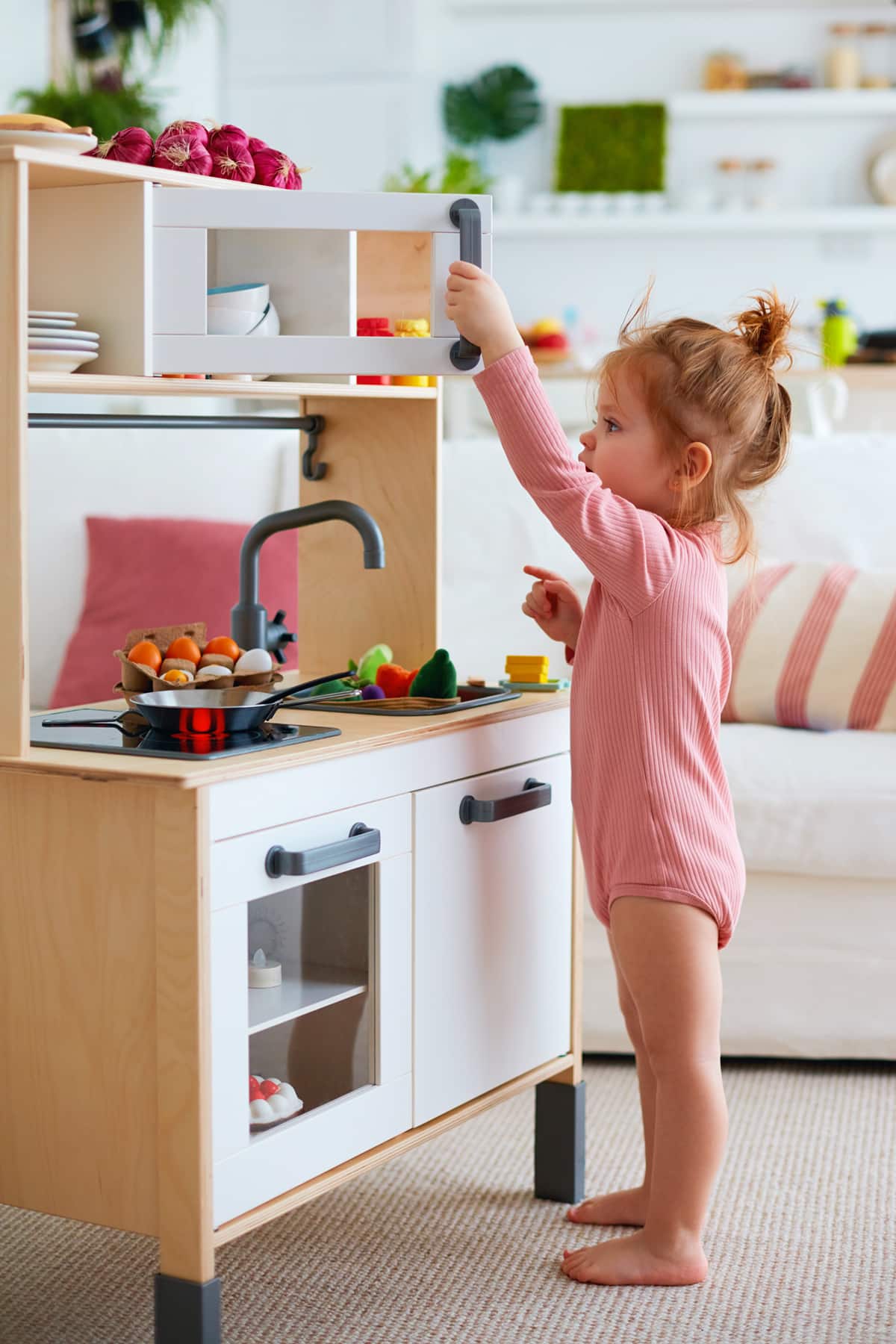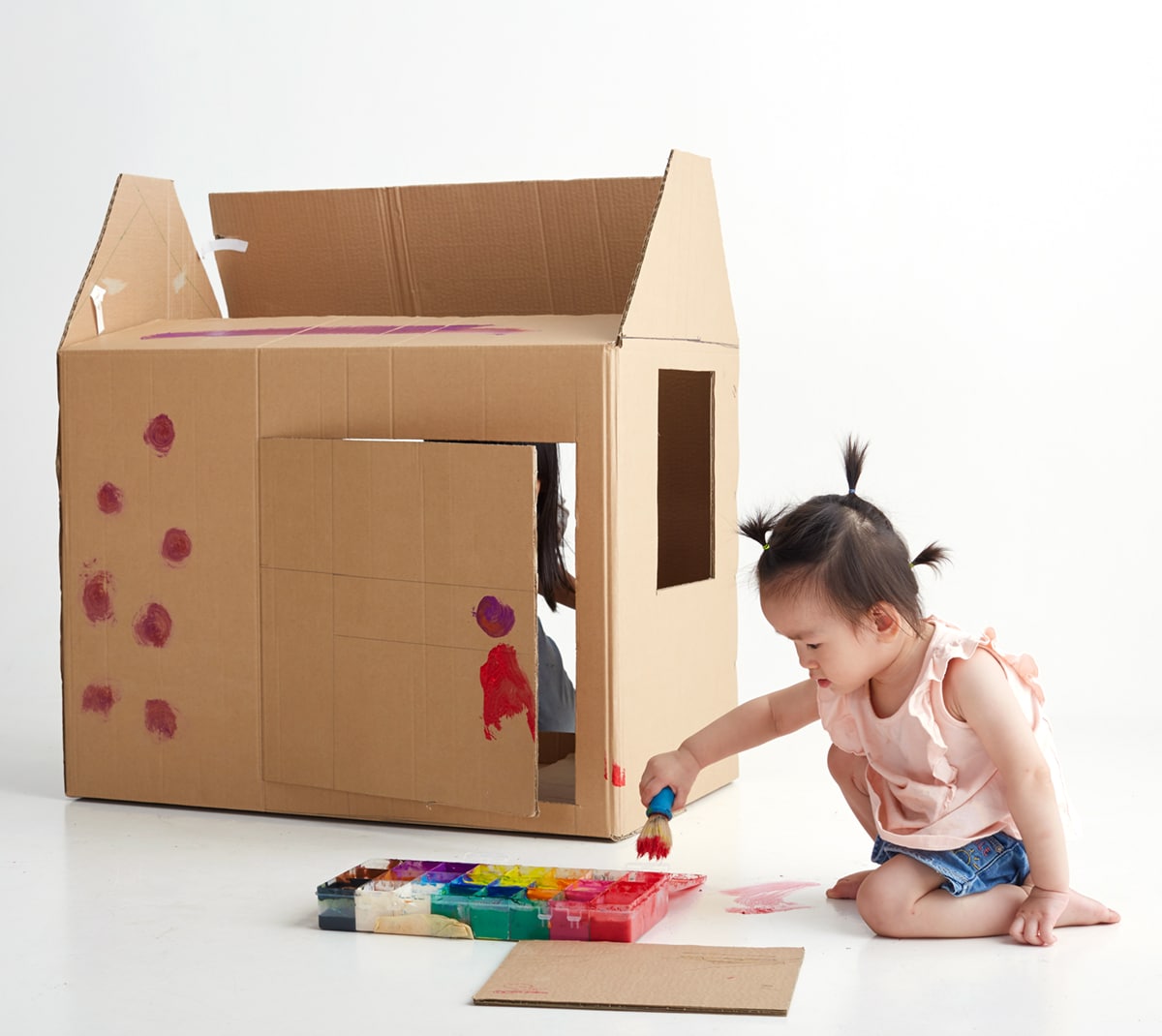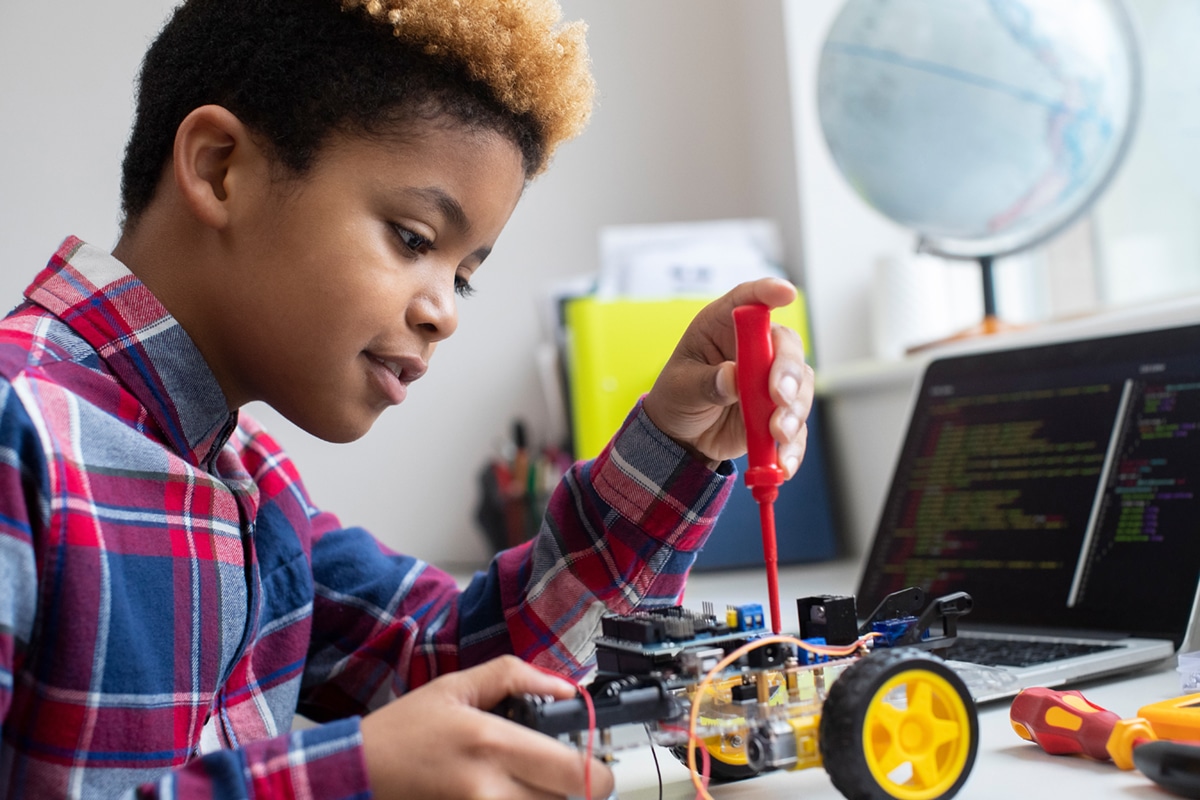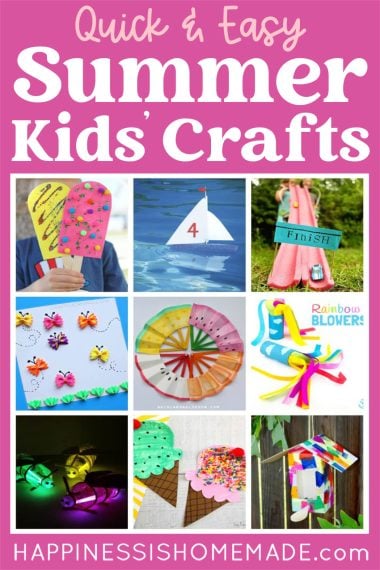What is Imaginative Play? Learn the benefits of imaginative play, plus get some fun ideas for encouraging imaginative play in kids of all ages – toddlers through high school!

This post may contain affiliate links. I will receive a small commission from these sales at no additional cost to you!
It’s hard to believe that just a few decades ago, psychologists were debating whether imaginative play was even necessary for children’s development. Now, we certainly know better! Pretend play is one of the most important things a child can do to develop creativity, problem solving skills, and social skills.
When it comes to imaginative play, there are no rules. Your child can be anyone they want to be, go anywhere they want to go, and do anything they want to do! This type of play is beneficial for children of all ages because it allows them to explore their creativity, learn new skills, have new experiences, try new things, and strengthen their imagination.
You May Also Want to Check Out:

What is Imaginative Play?
When you were a child, did you ever pretend to be a character from your favorite book? Or build a fort out of blankets and pillows? Did you ever have tea parties or make mud pies? Or play doctor’s office with your favorite teddy bear? If so, then you know the power of imaginative play!
Imaginative play is when children use their imaginations to create new worlds and experiences. It can be done alone or with others, and it doesn’t require any special equipment. Just a few simple props can spark a child’s imagination and help them to explore new ideas and feelings.

What are the benefits of imaginative play?
In addition to promoting cognitive development, imaginative play also helps children to express themselves emotionally. It provides a safe space for them to explore their feelings and try out different ways of handling difficult situations. Through pretend play, children can learn how to cope with anxiety and manage negative feelings and difficult emotions.

Here are just a few of the ways imaginative play can help kids at different stages of life:
For toddlers, imaginative play helps young children with brain development, problem-solving, and fine motor skills as they figure out how to use toys in new ways.
For preschoolers, imaginative play promotes language development and social skills as they interact with others in their make-believe worlds. It helps them to practice using their newly acquired language skills.
For school-aged kids, imaginative play allows them to explore new ideas and try out different roles in a safe and fun way. Pretend play provides an opportunity to work through anxieties and fears and it can also help to develop decision-making skills and creative problem-solving skills.
And for teenagers, make-believe allows them to experiment with different identities and explore different aspects of their personality.

How to encourage imaginative play
Imaginative play is important for children’s development. It helps them to learn about themselves and the world around them. It also supports their cognitive, social, emotional, and physical development. When children are playing imaginatively, they are actively engaged in learning.
Here are some examples of imaginative play ideas for encouraging imaginative play in your child at various age levels.

Toddlers & Preschoolers
One of the best things about toddlers and preschoolers are their boundless imaginations. Whether they’re pretending to be princesses, dinosaurs, or chefs in their play kitchens, imaginative play helps them explore the world around them and develop important cognitive skills. As a parent, there are lots of simple things you can do to encourage your child’s imagination.

One way to encourage imaginative play in young children is to provide them with open-ended toys that can be used in multiple ways. For example, instead of a toy car, try giving them a wooden block or cardboard boxes that can be transformed into whatever they want it to be. Give your child basic materials like clay, blocks, and dress-up clothes, and let them use their own creativity to turn them into whatever they want.
Second, resist the temptation to correct or direct their play. If your child wants to pretend that a block is a phone, that’s perfectly fine! Be sure to provide encouragement and praise when your toddler is engaged in make-believe play. This will help them understand that this type of play is valued and worth pursuing.

Third, make time for make-believe games together. Telling a story with finger puppets or having a pretend tea party can help spark your child’s imagination and bond with them at the same time. If they see you engaging in pretend play or role play, they will be more likely to imitate your behavior.

Elementary School
In this digital day and age, it’s getting harder and harder to keep kids off screens. Unfortunately, as kids get older, they often start to lose interest in make-believe. If you want to encourage your elementary school child’s imagination, it’s important to make time for and place value on imaginative play focused games and activities.
Again, providing them with plenty of opportunities for open-ended play is key. This means avoiding electronic toys and screen time, and instead opting for things like books, building blocks, dolls, and other STEM toys that can be used in multiple ways.
Instead of buying video games or apps for birthdays and holiday gifts, try to help your child develop an interest or passion in something active instead. Give them a football, basketball, or other sports equipment. If they’re into art or music, get them an easel or a new instrument. This is the perfect age to introduce things like skateboards, bicycles, and other outdoor gear! The less time they spend in front of screens, the more time they’ll have to explore their imaginations.

It’s also important that you provide opportunities for imaginative play. If you have a backyard, set up a mini obstacle course or build a fort out of blankets and pillows. Get involved in their creative play by being their coach, cheerleader, or audience member. This will help them feel supported in their endeavors and more likely to continue pursuing imaginative activities.

Middle School
By the time kids reach middle school, many of them have lost interest in imaginative play. They might think it’s childish or they may feel self-conscious about engaging in make-believe activities. As a parent, it’s important to support your child’s imagination during this time and help them find ways to express themselves creatively.
One way to do this is to encourage them to find imaginative outlets that they’re passionate about. If they’re interested in art, help them sign up for classes or get them a sketchbook. If they like music, buy them an instrument or help them join a band. There are also plenty of imaginative activities that can be done alone, such as writing stories or practicing photography.

It’s also important to provide older children with opportunities for creative activities. This can be as simple as going on a nature walk and collecting leaves, sticks, and stones to create art with. You can also make slime or have a family egg drop challenge. The key is to make time for imaginative fun and not force them.
In addition to making time for imaginative play, it’s important to encourage your child to use their imagination in everyday life. For example, when you’re cooking dinner together, ask them to come up with a new recipe. When you’re going on a road trip, have them be the navigator and make up the route as you go. If they see that you value their creativity, they’ll be more likely to engage in imaginative activities.

High School
Once kids reach high school, they’re often so focused on their social circles, academics and college that imaginative play takes a backseat. However, it’s important to continue to encourage your child’s imagination during this time. Studies have shown that imaginative play can help reduce stress, improve problem-solving skills, and increase creativity.
One great way to encourage imaginative play in teenagers is to provide them with plenty of opportunities to explore their creativity. This could mean giving them access to art supplies, musical instruments, or other materials that they can use to express themselves. Invite your teen to take a cooking class with you or spend a fun evening together at a ceramics or woodworking class.

If they’re not interested in those activities, try to find other ways to encourage their imagination. For example, you can ask them to help you plan your next vacation or come up with a new design for the living room. You can also try taking them to places that are rich in history and culture, or exposing them to new and different foods or experiences. The important thing is to provide them with plenty of opportunities to engage their imaginations.
Another great way to encourage imaginative play is to simply encourage teens to daydream and think outside the box. This can be done by asking open-ended questions, encouraging them to come up with creative solutions to problems, or simply encouraging them to think about what they would do if they had the power to do anything. The key is to create an environment where teenagers feel comfortable letting their imaginations run wild.

No matter the age, imaginary play is a great stress reliever and provides an opportunity for children to express their emotions in a healthy way. And they are having fun! As a parent, you can support your child’s imagination by providing opportunities for imaginative play and encouraging them to use their imagination in everyday life.
What are some ways you encourage imaginative play in your children or teenagers? We’d love to hear from you in the comments!

Check Out These Other Fun Kids Ideas!
Don’t Forget to Pin These Ideas for Later!


Heidi Kundin has captivated the hearts of millions with her colorful and inspiring approach to crafting, celebrations, and family fun. With over 15 years of experience, Happiness is Homemade has become a must-visit destination for those seeking quick and easy creative ideas and last-minute solutions. Heidi’s warm personality shines through her posts, inviting readers to join her on a creative journey that’s fun, rewarding, and achievable. Heidi is also the author of Homemade Bath Bombs & More and DIY Tie-Dye.








